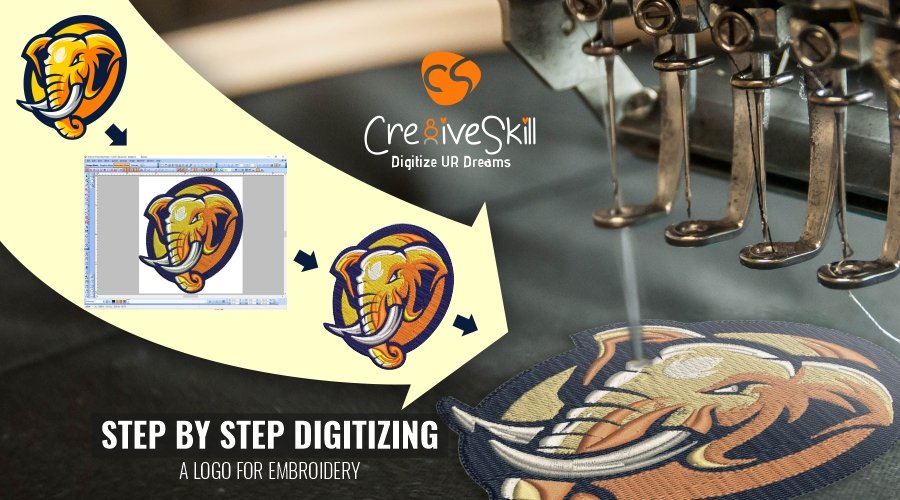Check Out Various Sorts Of Needlework Digitizing Methods
Needlework digitizing has developed dramatically over the years, providing a myriad of strategies to bring layouts to life in the electronic realm. The realm prolongs to extra advanced techniques like photorealistic needlework digitizing and the interesting world of 3D embroidery digitizing.
Traditional Hand Embroidery Digitizing
Standard hand needlework digitizing entails the process of converting elaborate hand-stitched designs into electronic layouts for equipment needlework. This strategy calls for skilled artisans to thoroughly analyze the handcrafted style and then utilize specialized software application to recreate it in a digital layout. Each stitch, shade, and information should be thoroughly translated to guarantee that the essence of the initial hand needlework is protected in the digital version.
Among the vital obstacles of standard hand needlework digitizing is catching the ins and outs and nuances of the handmade design. Digitizing for Embroidery. Craftsmens have to have a deep understanding of various needlework methods, such as satin stitch, chain stitch, and French knots, to accurately reproduce these techniques in the electronic world. Furthermore, they need to have a keen eye for detail to make sure that the electronic design maintains the same degree of virtuosity and workmanship as the original hand-stitched piece
Punching Method
To seamlessly change from traditional hand needlework digitizing to the boxing method, craftsmens need to currently concentrate on transforming the complex electronic layouts into instructions that needlework machines can translate. The boxing strategy includes using specialized software application to create digital data which contain commands for the embroidery device to comply with. This process requires a deep understanding of not just the design itself yet also the capacities and limitations of the embroidery maker.

Auto-Digitizing Software Application Programs
Needlework digitizing has actually been reinvented by the development of auto-digitizing software programs, providing artisans with advanced devices to convert digital designs right into embroidery device guidelines efficiently. Auto-digitizing software application utilize formulas to examine electronic pictures or vector data and generate needlework styles instantly. These programs allow for fast and accurate conversion of elaborate styles right into stitch patterns, saving effort and time for embroiderers.
One of the key advantages of auto-digitizing software is its straightforward interface, making it available to both novices and seasoned digitizers. These programs usually include features such as stitch editing tools, thread shade matching, and the capacity to preview the final stitched style. In addition, auto-digitizing software program can take care of complicated designs with numerous shades and complex details, creating top quality embroidery informative post data appropriate for different clothing and textile jobs.
While auto-digitizing software application uses benefit and effectiveness, it is essential for customers to understand the limitations of automated digitizing. Fine-tuning and hands-on modifications might still be needed to attain the preferred needlework quality, specifically when taking care of intricate or one-of-a-kind styles. By leveraging the capacities of auto-digitizing software application alongside manual digitizing techniques, craftsmens can improve their embroidery digitizing process and develop sensational embroidered pieces.
Photorealistic Needlework Digitizing
Utilizing sophisticated electronic imaging techniques, accomplishing photorealistic cause embroidery digitizing has ended up being a sought-after skill amongst modern-day artisans. This method entails converting high-resolution images right into intricate stitch patterns that carefully mimic the original layout, resulting in needlework items that display lifelike information and depth.
To achieve photorealistic embroidery digitizing, craftsmens have to have a keen eye for detail and a detailed understanding of exactly how different stitch types and densities can affect the last outcome. By thoroughly drawing up each color and color in the picture, embroiderers can produce a digital file that overviews the embroidery equipment to reproduce the subtleties of the initial image accurately.
Photorealistic embroidery digitizing is particularly popular in creating customized styles for clothing, home design, and art pieces where catching the essence of a photo or artwork is important. This method permits artisans to change memories, landscapes, portraits, and detailed artwork into sensational embroidered masterpieces that display a mix of typical craftsmanship and innovative technology.
3D Embroidery Digitizing
With the improvement of digital imaging techniques in accomplishing photorealistic cause needlework digitizing, the exploration of 'D Needlework Digitizing' uses a new dimension to the details of layout replication. 'D Embroidery Digitizing' describes the three-dimensional digitizing strategy that adds depth and appearance to needlework layouts, producing a much more reasonable and visually appealing end product. This technique uses software program that replicates the impact of light and shadow on the embroidery layout, improving its overall visual influence.
One of the key advantages of 'D Needlework Digitizing' is its capability to make styles look more lifelike and vibrant. By adding depth to the embroidery design, the end product appears more reasonable and captivating (Digitizing for Embroidery). In addition, this strategy permits even their website more innovative liberty in design implementation, allowing embroiderers to explore different appearances and effects that go to this site were previously testing to accomplish
Verdict

Comments on “Budget Friendly Digitizing for Embroidery: Accuracy and Information”